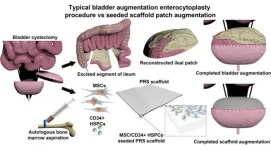New epidemiological tool provides warnings of heat and cold related mortality by sex and age in Europe
Forecaster.health, an open-access health early warning system for 580 regions in 31 European countries, has been funded by the European Research Council
2024-06-26
(Press-News.org)
Ambient temperatures are associated with over 5 million premature deaths worldwide every year, more than 300,000 of which in Western Europe alone. In a context of rapidly warming temperatures that successively broke previous records during the last two decades, it is essential to use epidemiological models to develop novel, impact-based early warning systems predicting the health effects of forecast temperatures.
This is precisely what the Adaptation group at the Barcelona Institute for Global Health (ISGlobal), a centre supported by the "la Caixa" Foundation, has done: Forecaster.health is the first pan-European, open-access platform using sex- and age-specific epidemiological models to predict the actual mortality risks of ambient temperatures for different segments of the population.
The tool allows users to enter the date for which they want to obtain the health predictions within a window of up to two weeks, as well as the population subgroup for which they want to obtain the prediction of temperature related mortality. Once these variables have been selected, the system displays a map showing warnings for 580 regions in 31 European countries with colour codes corresponding to four levels of heat and cold related mortality risk: low, moderate, high and extreme.
Change in paradigm: from meteorology to epidemiology
"Until now, temperature warnings have been solely based on the physical information of weather forecasts, and therefore, they ignore the differences in vulnerability to heat and cold among population groups. Our system changes this paradigm by shifting the focus from meteorology to epidemiology and the social determinants of vulnerability to the environmental factors", says Joan Ballester Claramunt, principal investigator of the Adaptation group at ISGlobal. "Forecaster.health does not only forecast the temperatures themselves, but also the actual risks that these temperatures have on the population as a whole, and especially, on specific population subgroups based on sex and age", he adds.
More precise than weather forecasts
The team used the mortality database of the project EARLY-ADAPT (https://www.early-adapt.eu), which currently includes data for 580 regions in 31 European countries by sex, age and cause of death, to fit separate epidemiological models for population groups. Every day, the tool obtains temperature records and forecasts, and uses the epidemiological models to quantify the risk of temperature related mortality by sex and age group for any given date within the following 15 days.
“We know that vulnerability to heat is influenced by a number of factors, including sex and age. We know, for example, that women are more susceptible to heat than men, and that the risk of death for both heat and cold increases with age. For that reason, our tool separately fits epidemiological models for each sex and age group, which allows us to issue independent warnings accounting for the real impacts on the population”, says Marcos Quijal-Zamorano, researcher at ISGlobal and one of the authors of the system.
The first step towards a multi-hazard platform
Always based on epidemiological evidence and models, Forecaster.health will be expanded in the next months and years in different directions. To begin with, new countries and smaller regions will be added to the platform, as soon as new data is acquired by the team. The tool is also expected to develop new epidemiological models to incorporate health warnings for several air pollutants, such as particulate matter, ozone or nitrogen dioxide. Finally, the platform will also issue warnings for specific causes of death, such as cardiovascular and respiratory diseases, and for other health outcomes, such as hospital admissions and occupational accidents.
“Our approach crucially depends on the availability of health data to fit our epidemiological models. We are eager to add additional health outcomes for more countries or smaller regions, either from Europe or in other continents, if data is provided to us”, emphasises Joan Ballester Claramunt.
Proof-of-Concept Grants of the European Research Council
Forecaster.health has been funded by the Proof-of-Concept Grants HHS-EWS and FORECAST-AIR of the European Research Council (ERC). These grants are aimed at transforming the basic research and resources generated in the ERC Consolidator Grant EARLY-ADAPT into innovative tools to address societal challenges. In that regard, EARLY-ADAPT is studying how populations are adapting to the public health challenge of climate change, and consequently, HHS-EWS and FORECAST-AIR are offering real solutions to increase the resilience of societies to environmental threats such as ambient temperatures and air pollutants.
The team that developed the platform is composed by Joan Ballester Claramunt, Mireia Beas-Moix, Nadia Beltrán-Barrón, Raúl Fernando Méndez Turrubiates, Fabien Peyrusse and Marcos Quijal-Zamorano.
NOTE FOR JOURNALISTS:
Access to the tool: Until the embargo is lifted, the tool will be accessible with the following credentials:
URL: https://forecaster.health/
User: media
Password: ISGlobal@heat2024! END
ELSE PRESS RELEASES FROM THIS DATE:
2024-06-26
As critical pollinators, bees keep our agricultural systems going — but human-caused changes to the planet heavily impact their foraging options. To help protect our food security, we need more information about bees’ own dietary requirements. Scientists writing in Frontiers in Sustainable Food Systems studied the nutritional value of 57 types of pollen and found that bees need to forage from a variety of plants to balance their diet between fatty acids and essential amino acids.
“Despite public interest and a rise in pollinator plantings, little is known ...
2024-06-26
Even though there is substantial variability in the contents and nutritional profiles of plant-based meat alternatives (PBMAs), the nutritional profiles tend to reflect a heart-healthy dietary pattern. A review article appearing in the Canadian Journal of Cardiology, published by Elsevier, of the available studies directly comparing the impact of plant-based and animal-based meats consistently suggests that the plant-based alternatives improve cardiovascular risk factors.
PBMAs are highly processed plant-based food products that typically replace meat in the diet. ...
2024-06-26
Convolutional Neural Networks (CNNs), with its exceptional image recognition capabilities, have performed outstandingly in the field of AI and notably within platforms like ChatGPT. Recently, a team of Chinese researchers from University of Shanghai for Science and Technology have successfully introduced the concept of CNNs into the field of optics and realized convolutional all-optical neural network, bringing revolutionary progress to AI imaging technology.
Led by Prof. Min Gu and Prof. Qiming Zhang from School of Artificial Intelligence Science and Technology (SAIST) at the University of Shanghai for Science and Technology ...
2024-06-26
SINGAPORE — Scientists have generated a comprehensive map of the gene targets regulated by the transcription factors HNF4A and HNF1A in human pancreatic beta cells and liver cells. Published in the journal Nature Communications, the study revealed common and tissue-specific molecular pathways regulated by HNF4A and HNF1A, two proteins that possess important functions governing the development and function of the pancreas and liver.
Notably, the scientists identified several novel gene targets in pancreatic beta cells, the cells responsible for insulin ...
2024-06-26
More than 100,000 oil and gas wells across the western U.S. are in areas burned by wildfires in recent decades, a new study has found, and some 3 million people live next to wells that in the future could be in the path of fires worsened by climate change.
Researchers from the University of California, Berkeley, said their analysis, which was published last week in the journal One Earth, is the first to examine historical and projected wildfire threats on oil and gas facilities in the U.S. While the public health effects of scorched and damaged drill sites are unclear, researchers said the study is a necessary step ...
2024-06-26
DALLAS, JUNE 25, 2024 — Cardiovascular disease is the leading cause of death for women, and gaps in care and access persist between women and men. Addressing those gaps could lead to an increase of at least 1.6 million years of quality life and boost the U.S. economy by $28 billion annually by 2040, according to a new report published today by the American Heart Association and the McKinsey Health Institute (MHI). To help close these gaps and foster gender specific cardiovascular disease science into implementation, the Association, observing 100 years of lifesaving service as the world’s leading nonprofit organization ...
2024-06-26
(Santa Barbara, Calif.) — Computers have come so far in terms of their power and potential, rivaling and even eclipsing human brains in their ability to store and crunch data, make predictions and communicate. But there is one domain where human brains continue to dominate: energy efficiency.
“The most efficient computers are still approximately four orders of magnitude — that’s 10,000 times — higher in energy requirements compared to the human brain for specific tasks such as image processing and recognition, although they outperform the brain in tasks like mathematical calculations,” said UC Santa Barbara ...
2024-06-25
Biogenic monoamines — molecules like dopamine and serotonin — are famous for their role as the brain’s emissaries of mood, learning and memory, stress mechanisms, and fight-or-flight responses in the body.
But these neurotransmitters existed in nature long before brains popped up in the evolutionary tree. They’re prevalent in plants, bacteria, and single-cell organisms as well, but their functions there are far less understood.
Scientists at the Morgridge Institute for Research have added another task for ...
2024-06-25
DURHAM, N.C. -- There’s a strong chance that last week’s scorching temperatures were even hotter than reported for those living in underserved urban areas.
It’s been well established that more impoverished areas within cities are typically hotter than their wealthier neighborhoods. Dubbed “urban heat islands,” these communities have more buildings, less vegetation and somewhat higher population density, which combine to produce the heating effect.
New research from environmental engineers at Duke University has shown that citizen science tools used to gauge heat in these ...
2024-06-25
A functional, healthy bladder is something that many of us take for granted. Yet millions of Americans deal with bladder issues, ranging from temporary inconveniences to long-lasting conditions. While many bladder disorders can be managed with non-invasive solutions, some conditions may require surgery to restore bladder function.
In patients with major bladder issues, a cystectomy may need to be performed. In this procedure, some or all of the bladder is removed (reasons for this may include acute trauma or bladder cancer). Sometimes, to compensate for the loss of tissue, the bladder is augmented (made larger), typically with ...
LAST 30 PRESS RELEASES:
[Press-News.org] New epidemiological tool provides warnings of heat and cold related mortality by sex and age in Europe
Forecaster.health, an open-access health early warning system for 580 regions in 31 European countries, has been funded by the European Research Council



